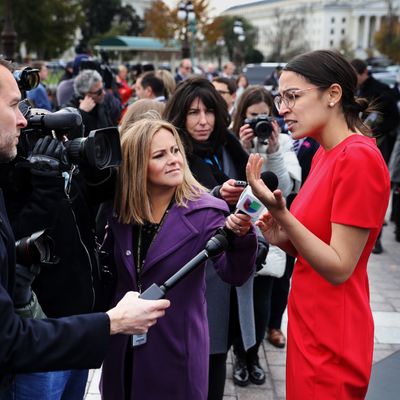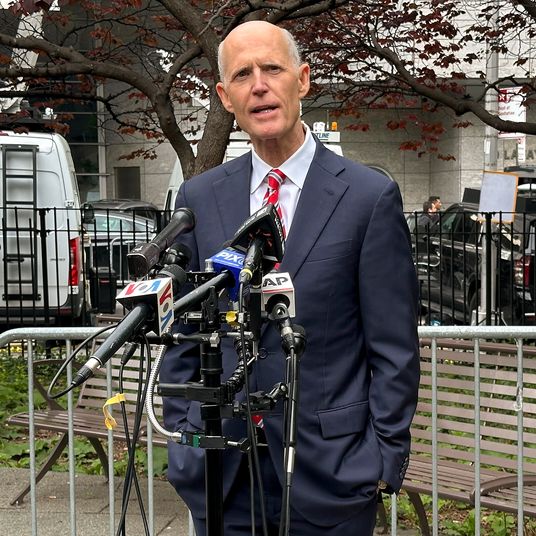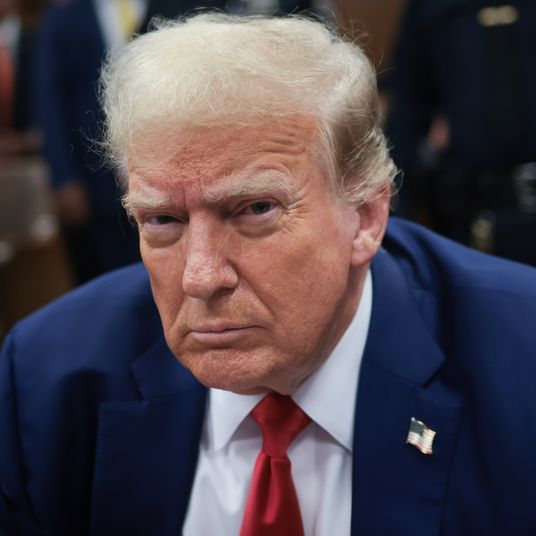
There are 101 new House members in the 116th Congress. Approximately 99 percent of these fresh-faced lawmakers do not identify as socialists. Thirty of the newly elected Democrats have joined their party’s pro-business caucus — which now boasts roughly as many members as its “progressive” one. For all the chatter about a “tea party of the left,” the Democratic center held in 2018: With a handful of exceptions, Establishment-backed incumbents triumphed in their primaries, while swing-district moderates prevailed in November.
But the corporate media doesn’t want to talk about that.
In its single-minded quest to maximize shareholder value, the for-profit Fourth Estate has been suppressing centrist ideas in favor of socialist ones. The bourgeois press hasn’t run a word on House freshman Ben McAdams’s “all of the above” energy policy — even as it’s published near-daily features on Alexandria Ocasio-Cortez’s “Green New Deal.” The major networks have ignored Jeff Van Drew’s thoughts on improving the Obamacare exchanges, even as they’ve given Ocasio-Cortez a prime-time platform to call for nationalizing the health-insurance industry. Major newspapers have buried the New Democrat Coalition’s plans for real corporate tax reform, while devoting multiple columns to the socialist congresswoman’s extemporaneous reflections on soaking the rich.
These editorial choices haven’t merely exaggerated the left’s influence within the Democratic Party – they’ve actively increased it. Ocasio-Cortez has translated her disproportionate media coverage into disproportionate power, extracting coveted committee appointments from the House leadership, and policy commitments from her party’s 2020 hopefuls. Which is to say: The corporate media has been manufacturing dissent.
Of course, for-profit news outlets do not actually have an anti-capitalist bias. Ocasio-Cortez secured privileged access to such influential platforms by first establishing her own. The congresswoman’s mastery of social media has won her a massive, personal audience of extremely online millennials — whose eyeballs just happen to be more valuable to advertisers than (virtually) any other demographic’s. Major news outlets haven’t put “AOC” in their spotlights because they admire her ideology, but because they covet her audience. Mainstream coverage of Ocasio-Cortez has (typically) treated her policy views with suspicion, if not contempt. But adversarial publicity is good publicity for a freshman House member (and a long-marginalized socialist movement). Ocasio-Cortez may have had to build her own social-media megaphone to attract 60 Minutes’ attention — but once she did, that program provided her with an even louder megaphone. As prime-time appearances have swelled her following, AOC’s influence has reached unprecedented heights: Over the past month, her Twitter account has generated more interactions than America’s five most prolific news organizations combined. For this reason, among others, the objective consequence of mainstream reporting on AOC has been to push the Democratic Party in her direction (as the New York Times just objectively reported). Through the sheer power of her Twitter “dunks,” the congresswoman has turned the corporate media into an agent of socialist change.
This development complicates the conventional left-wing critique of American mass media. In Noam Chomsky’s influential account, our nation’s corporate-owned news outlets perform “a system-supportive propaganda function” analogous to that of state-owned media in one-party dictatorships. Of course, in our liberal democracy, this propagandistic effect isn’t achieved through overt coercion, but “by reliance on market forces, internalized assumptions, and self-censorship.” Dissent isn’t (usually) suppressed, but elite gatekeepers guard the boundaries of respectable opinion. This is less oppressive than authoritarian modes of policing public discourse, but it might also be even more effective: As Chomsky argues, “the smart way to keep people passive and obedient is to strictly limit the spectrum of acceptable opinion, but allow very lively debate within that spectrum.”
During the run-up to George W. Bush’s invasion of Iraq 16 years ago, this critique looked quite compelling. But today, like so many of the apps on your smartphone, Chomsky’s theory is overdue for an update. In 2019, market forces aren’t limiting the spectrum of acceptable opinion, so much as they’re expanding it.
There is a purely editorial argument for covering Ocasio-Cortez closely. A millennial bartender ousting a ten-term Democratic incumbent is newsworthy by the most conventional definition; as is the spectacle of a first-term congresswoman cheering on an occupation of her party leader’s office. What’s more, Ocasio-Cortez’s policy ideas concern some of our nation’s most pressing (and under-discussed) challenges, while her “fish out of water” political persona is the stuff of which Hollywood films were once made. In publicizing all the alienating (but heretofore invisible) aspects of how Congress works to her digital constituents, AOC has made many of them feel genuinely represented in the halls of power for the first time in their lives. She is the downwardly mobile millennial’s ambassador to Congress — and evinces no interest in assimilating to that foreign culture.
Nevertheless, it’s hard to imagine this argument would have prevailed in the pre-digital age. Back when editorial judgement was centralized in the prestigious newsrooms of legacy media outlets — and editors-in-chief had (relatively) little data about which topics piqued reader interest — it’s doubtful that the mainstream press would have chronicled the every move of a freshman congresswoman with “far left” views. In other words, if the American media were less beholden to market pressures, it would (almost certainly) be giving less coverage to AOC’s calls for decommodification. The corporate media’s obligation to maximize ad revenue by maximizing viewership — combined with its newfound ability to see the infotainment market through Chartbeat’s all-knowing eyes — has left it no choice but to elevate its opposition.
Of course, one could make a similar argument about media coverage of Donald Trump in 2015. And many have. For all the spurious analogies that centrist pundits have drawn between the far right and socialist left, it is true that Ocasio-Cortez and Trump both owe their power to the way social media has undermined elite gatekeeping. As Twitter mobs have wrested control of the Overton window from “system supportive” elites, they’ve opened our national conversation to more egalitarian economic ideas — but also to less egalitarian racial ones. Weak parties and decentralized media enabled a Bronx bartender to oust a complacent incumbent, and force Congress to confront the scale of action necessary for averting ecological catastrophe; but they also allowed a Queens con man to commandeer the nuclear codes.
To this point, however, commentary on the decline of elite gatekeeping has focused almost exclusively on that latter consequence. Some of the most influential diagnoses of our democracy’s present woes have prescribed stronger party Establishments — and less democratic intraparty governance — as necessary tonics. Ocasio-Cortez’s emergence invites the hope that a better remedy is possible. Perhaps, we can replace “manufactured consent” with inconvenient truths (instead of alternative facts), a discredited Establishment with earnest reformers (instead of cynical demagogues), and corporate technocracy with some approximation of genuine self-rule (instead of authoritarian populism).
Perhaps.































